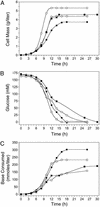Engineering the metabolism of Escherichia coli W3110 for the conversion of sugar to redox-neutral and oxidized products: homoacetate production
- PMID: 12556564
- PMCID: PMC298686
- DOI: 10.1073/pnas.0337684100
Engineering the metabolism of Escherichia coli W3110 for the conversion of sugar to redox-neutral and oxidized products: homoacetate production
Abstract
Microbial processes for commodity chemicals have focused on reduced products and anaerobic conditions where substrate loss to cell mass and CO(2) are minimal and product yields are high. To facilitate expansion into more oxidized chemicals, Escherichia coli W3110 was genetically engineered for acetate production by using an approach that combines attributes of fermentative and oxidative metabolism (rapid growth, external electron acceptor) into a single biocatalyst. The resulting strain (TC36) converted 333 mM glucose into 572 mM acetate, a product of equivalent oxidation state, in 18 h. With excess glucose, a maximum of 878 mM acetate was produced. Strain TC36 was constructed by sequentially assembling deletions that inactivated oxidative phosphorylation (deltaatpFH), disrupted the cyclic function of the tricarboxylic acid pathway (deltasucA), and eliminated native fermentation pathways (deltafocA-pflB deltafrdBC deltaldhA deltaadhE). These mutations minimized the loss of substrate carbon and the oxygen requirement for redox balance. Although TC36 produces only four ATPs per glucose, this strain grows well in mineral salts medium and has no auxotrophic requirement. Glycolytic flux in TC36 (0.3 micromol.min(-1).mg(-1) protein) was twice that of the parent. Higher flux was attributed to a deletion of membrane-coupling subunits in (F(1)F(0))H(+)-ATP synthase that inactivated ATP synthesis while retaining cytoplasmic F(1)-ATPase activity. The effectiveness of this deletion in stimulating flux provides further evidence for the importance of ATP supply and demand in the regulation of central metabolism. Derivatives of TC36 may prove useful for the commercial production of a variety of commodity chemicals.
Figures





References
-
- Akesson M, Hagander P, Axelsson J P. Biotechnol Bioeng. 2001;73:223–230. - PubMed
-
- Contiero J, Beatty C, Kumar S, DeSanti C L, Strohl W R, Wolfe A. J Ind Microbiol. 2000;24:421–430.
-
- Aristidou A A, San K, Bennet G N. Biotechnol Prog. 1995;11:475–478. - PubMed
-
- Chotani G, Dodge T, Hsu A, Kumar M, LaDuca R, Trimbur D, Weyler W, Sanford K. Biochim Biophys Acta. 2000;1543:434–455. - PubMed
Publication types
MeSH terms
Substances
LinkOut - more resources
Full Text Sources
Other Literature Sources
Molecular Biology Databases
Miscellaneous

